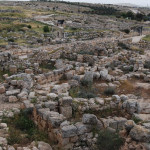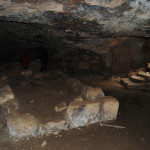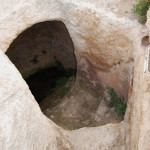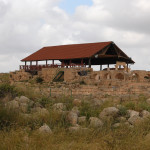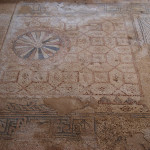Susya National Park (Israel)
The Susya National Park is located in the southern Judean Mountains in Israel, 53 kilometres from Jerusalem. The park was founded on the site, where back in the ancient times the city bearing the same name Susya was located.
The name Susya is known to us from the Arabs, who lived in the caves and among the ruins of the ancient city before 1967. A few decades ago, a document dating from the Crusaders’ times (1110) was published that mentions the place named Sussia (King Baldwin I granted some portions of the land in the Hebron area to Hospitalers, including Susya). At the same time, the name Susya is not found in any earlier historic or archaeological sources known to us from the period when the city existed and prospered.
While interpreting numerous archaeological finds, scientists and archaeologists concluded, that the city came into being at the time of the start of the Byzantine Empire1, that is, in the 4th century A.D. It is known, that in those times, the Jewish population was prohibited by the authorities from living in Jerusalem and its vicinities, therefore, the Jews were forced to settle down in new places. One of such places was the settlement in Susya.
There is another version, according to which Susya was founded at the end of the 2nd century B.C. (112-113), after the Hebron Hills were conquered by the Hasmoneans. At that time, not far from the old settlements Carmel and Maon, and near a small Hasmonean fortress Rujm el-Hamiri, several family agricultural households were founded in the area, which later received the name Susya. In the Roman period, after the suppression of Bar Kokhba revolt (132-135 B.C.), these farms grew into a large Jewish settlement with centralized town planning and well-developed social life.
The first one to discover the city was Reverend Henry Baker Tristram (1822-1906) – an English clergyman, scholar, traveller, and ornithologist, who back in 1864, left a description of a large building and a column near its entrance. In those years, other British explorers visited Susya also, as well as a French explorer Victor Guérin. They documented the location of the streets and alleys, and the already known large building. Nobody could guess the purpose of the discovered large building with columns at its entrance.
After the Six-Day War (June 5-10, 1967), the territory became available for visitations and researches, and that is when the serious excavations began. In the early 1970s, archaeologists Gutman, Yeivin, and Netzer found a mosaic that shed some light on the intended purpose of this building – it was a synagogue.
Susya was a large and well-organized city, with a broad main street, trading shops, craftsmen’ workshops, public, and religious facilities, and community life. Archaeological finds prove that the city produced wine, olive oil, and there was a mill and some pottery production.
Susya was a large and well-organized city, with a broad main street, trading shops, craftsmen’ workshops, public, and religious facilities, and community life. Archaeological finds prove that the city produced wine, olive oil, and there was a mill and some pottery production.
The jewellery, Hebrew inscriptions, and symbols engraved into stones and mosaics, as well as mikvahs, and a luxurious building of the synagogue testify of the mainly Jewish population of the city, the estimate of which could reach up to 3,000 people.
The synagogue that dates back to the 4th-7th centuries, which was used until the 9th century, is especially interesting and valuable.
The architectural design, particularly the eastern entrance and axis of prayer, prove that the dwellers of Susya kept the traditions of the ancient halakhic law2, which had been forgotten by that time in Galilee, but was still practiced in Judea, because of geographical proximity to Jerusalem, where many ancient traditions had been kept.
The eastern orientation was also related to the idea of dissuading heretics and Christians in the same region, who bowed in the eastern direction and believed that the Divine Presence dwells in the east.
The synagogue was built not as a basilica, but rather as a “broadhouse” (a building without columns). The size of the synagogue is 9 by 16 metres; it is built of white stones of equal size, with the triple door facade in the eastern direction. The bema (platform) and niche for Torah were at the centre of the northern wall. In the eastern section there was the second bema.
Unlike other synagogues in Judea, this one had a gallery, which was made to support the western wall. East of the synagogue was an open courtyard, surrounded on three sides by a roofed portico. The western side opened to the synagogue’s narthex. The floor of the narthex was composed of coloured mosaics, set in an interlaced pattern.
In Susya synagogue, unlike the majority of other Galilean synagogues, the niche was made in the northern wall, facing Jerusalem, and the entrance – in the eastern wall. The floor of the synagogue, laid with limestone tiles (tesserae), has three mosaic panels.
On the eastern panel there is a picture of the Torahs’ Ark, two menorahs, from the upper branches of which two lamps are hanging, probably symbolizing the connection between the synagogue and the Temple, and probably also because the place where Torah was read was surrounded by lamps. The lamps shed light on the bema, attracting the attention to it and allowing to read the Torah. These lamps looked like a mirror reflection of the two menorahs on the mosaics, with the purpose to emphasize the central significance of the Torah.
The mosaic also contains the images of a lulav3 and etrog4 – plants that are used during the holiday of Sukkot, with two columns on both sides.
Next to the columns there is a landscape with deers and rams. The central panel is composed of geometrical and floral ornaments. The decoration in the shape of a wheel in front of the central bema led archaeologist Gutman to the idea that it was the remnant of a Zodiac wheel.
The Zodiac mosaics present an important evidence of that time, because their construction was systematically suppressed by the church, and their frequent construction in the floors of Palestinian synagogues was an indication of the inclusion of non-Jewish motifs into the Jewish art and their later “Judaization.”
The fragmentary condition of the mosaic wheel is explained by its later refurbishing into rough geometric shapes, maybe because it did not go along with the later standards of religious images. One more mosaic, which probably depicted Daniel in the lion’s den, like the mosaic at Naaran near Jericho and Ein Samsam in the Golan, was also defaced, and only some of its fragments have survived.
The figure with outstretched hands, as if calling to prayer, flanked by lions was erased from the mosaic to make it match the more recent trends.
According to the new trends in religious art, the design was to change to discard the iconographic forms that were considered inappropriate in the later epoch. Only the last two letters have survived in the name of Daniel, and this is the only thing that makes it possible to identify it.
Another unique characteristic of Susya is the presence of the abundant inscriptions. Four of them were laid in mosaics: two in Hebrew, which was a spoken language of that region at the time, and two in Aramaic. Nineteen fragmentary inscriptions, some of them in Greek, were cut in the marble of the building proper. According to these inscriptions, the synagogue was supported by the offerings of common people and it was not run by priests.
Approximately in the 10th century, after the Jews left the city, the synagogue was rebuilt into a mosque. The niche in the northern wall, which was used as a mihrab, according to the local tradition, dates to Saladin’s times.
In the 12th-13th centuries, the Crusaders camped in the neighbouring Chermala and Eshtemoa, and, following them, new families moved to the forsaken ruins to exploit the fertile land.
1The Byzantine Empire, Byzantinae, Eastern Roman Empire (395-1453) — is a state, which was formed in 395 in the wake of the ultimate split of the Roman Empire, after the death of Emperor Theodosius I, into the Western and the Eastern Empires. Less than eighty years later after the split, the Western Roman Empire ceased to exist, leaving the Byzantine Empire as the historical, cultural, and civilizational successor of Rome for almost ten centuries of history of Late Antiquity and into the Middle Ages.
2The Halakhah (halakhic law) — is a traditional Jewish law, the collective body of laws and instructions of Judaism, regulating the religious, family, and social life of religious Jews. In a narrower sense, it is the collection of laws from Torah, Talmud, and later Rabbinic literature, and every law (halakhot) among them in particular.
3Lulav — (literally a shoot, young branch) is: a) a frond of date palm with closed leaves; b) a bouquet of four kinds of plants (Four Species) that must be gathered together at Sukkot; c) a mitzvah (commandment) concerning the gathering of four kinds of species at Sukkot. Tied into a bunch with the myrtle and willow branches, lulav together with etrog, composed the so-called Four Species, ordained by the Bible for the ritual of celebrating the feast of Sukkot (Leviticus 23:40).
4Etrog, Citron, Cedrat — is a species of perennial plants from the Citrus genus of Rutaceae family.


